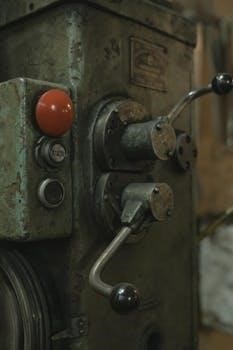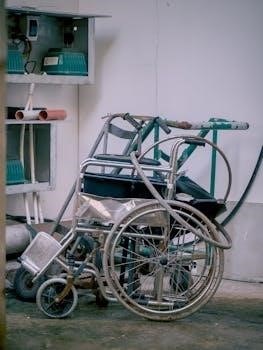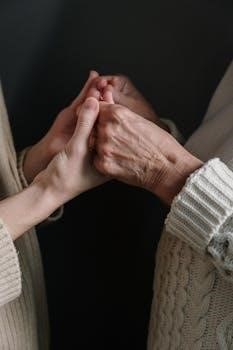Manual handling in aged care involves safely lifting, moving, and supporting elderly individuals. Proper techniques and equipment are essential to prevent injuries for both caregivers and the elderly, ensuring comfort and safety during transfers and daily tasks.
Importance of Safe Manual Handling
Safe manual handling is paramount in aged care to protect both caregivers and elderly individuals from injuries. Improper lifting techniques can lead to musculoskeletal disorders in caregivers, such as back pain and strains. For elderly individuals, unsafe handling can result in falls, fractures, and other serious injuries, impacting their quality of life and independence. Implementing safe practices promotes dignity, comfort, and a positive care environment. It also reduces the risk of litigation and healthcare costs associated with handling-related injuries. Prioritizing safe manual handling ensures a safer, healthier, and more respectful environment for everyone involved in aged care. This commitment fosters trust and well-being.
Understanding Risks in Manual Handling
Manual handling in aged care poses significant risks, including injuries to caregivers and the elderly. Improper techniques can lead to falls, strains, and other serious health complications. Awareness of these risks is crucial.
Risks to Caregivers
Caregivers face numerous risks when manually handling elderly individuals, primarily due to the physical demands of lifting and transferring. These risks include back injuries, such as strains and sprains, which can result from improper lifting techniques or overexertion. Additionally, caregivers may experience shoulder injuries, neck pain, and muscle fatigue. These injuries can significantly impact their ability to perform their duties and their overall well-being; The lack of proper training and the failure to use assistive equipment increase the likelihood of these injuries. Moreover, caregivers may develop chronic pain conditions over time, highlighting the importance of safe manual handling practices. Ignoring these risks not only harms caregivers but also affects the quality of care provided.
Risks to Elderly Individuals
Elderly individuals are particularly vulnerable to injuries during manual handling, with falls being a major concern. Improper lifting techniques can cause fractures, dislocations, and soft tissue injuries. The frailty of their bones and muscles increases their susceptibility to these injuries. Additionally, improper handling can lead to discomfort, pain, and a loss of dignity. Transfers that are not performed correctly can cause fear and anxiety, further impacting their well-being. There is also a risk of skin tears and bruising, especially when not using proper lifting techniques. Neglecting safe practices can lead to serious complications, negatively affecting their recovery and quality of life. Therefore, careful and gentle handling is crucial to protect their physical and emotional health.

Basic Principles of Safe Lifting Techniques
Safe lifting involves maintaining proper body mechanics, such as bending knees and keeping a straight back; Assessing the situation and using assistive equipment are crucial to prevent injuries for both caregivers and the elderly.
Maintaining Proper Body Mechanics
Maintaining proper body mechanics is crucial for safe manual handling in aged care. This involves keeping your back straight, bending at your knees, and using your leg muscles to lift. A wide base of support enhances stability, while keeping the load close to your body reduces strain. Avoid twisting motions, instead pivot your feet to change direction. Proper alignment of your head and neck with your spine is also important. These techniques minimize the risk of injury for caregivers and ensure safer transfers for elderly individuals, promoting well-being and comfort. Remember to engage core muscles for added support.
Assessing the Situation Before Lifting
Before any lifting or transferring of an elderly individual, a thorough assessment is essential. Evaluate the person’s mobility, strength, and cooperation level. Check the environment for obstacles, ensuring a clear path. Consider the weight and size of the individual, determining if assistance or assistive devices are needed. Communicate with the person to understand their needs and preferences. It is crucial to plan your movement in advance, ensuring a smooth and safe transfer. This proactive approach minimizes the risk of injury, promoting a secure and comfortable experience for both the caregiver and the elderly person. Proper assessment is key to safe handling.

Practical Lifting and Transfer Techniques
Effective lifting and transfer methods involve using proper body mechanics, clear communication, and assistive devices. Techniques vary based on the situation, ensuring the safety and comfort of the elderly individual.
Lifting from a Chair or Bed
When assisting an elderly person from a chair or bed, begin by assessing their capabilities and the environment. Position yourself close, ensuring a stable base of support. Encourage the individual to participate as much as possible by pushing off with their arms if able. Use a gentle, controlled motion, avoiding any sudden jerks. If needed, employ assistive devices like transfer belts for added support and safety. Always maintain proper body mechanics, keeping your back straight and using your leg muscles to lift, not your back. Ensure a clear path to the destination, and communicate each step to the person being moved to reduce anxiety and promote cooperation during the transfer.
Lifting an Elderly Person From the Floor
Lifting an elderly person from the floor requires careful planning and execution. First, assess their condition and check for any injuries. Ensure a clear space and gather any necessary assistive equipment like a mechanical lift. Communicate with the individual, explaining each step to alleviate anxiety. Position yourself close, using a stable stance and bending at the knees, not the waist. Encourage them to assist by pushing up if possible. Use a slow, controlled lift, engaging your leg muscles while keeping your back straight. Avoid sudden movements. If you are unable to lift them safely, call for assistance. Once lifted, move them to a safe chair or bed for rest and further assessment.

Use of Assistive Equipment
Assistive equipment like mechanical lifts, slings, transfer boards, and belts are crucial for safe manual handling. These tools reduce strain on caregivers and ensure safer, more comfortable transfers for elderly individuals.
Mechanical Lifts and Slings
Mechanical lifts and slings are essential tools for safely transferring elderly individuals with limited mobility. These devices significantly reduce the physical strain on caregivers, preventing potential back injuries and other musculoskeletal issues. Lifts come in various forms, including floor-based and ceiling-mounted models, each designed to accommodate different needs and environments. Slings are used in conjunction with lifts, providing a secure and comfortable support for the individual during transfer. Proper training is crucial for the correct and safe use of these devices, ensuring both caregiver and elderly individual safety and well-being. Mechanical aids such as these make moving individuals more dignified and far less risky for all involved.
Transfer Boards and Belts
Transfer boards and belts are invaluable assistive devices for facilitating safe and efficient movement of elderly individuals. Transfer boards, typically made of smooth, rigid material, bridge gaps between surfaces, such as a bed and a wheelchair, allowing for a smoother transition. Transfer belts, often featuring handles, provide caregivers with a secure grip when assisting an individual with movement and transfers, reducing the risk of slips or falls. These tools are essential for situations where manual lifting is dangerous or impractical, supporting independence and dignity. Proper usage, coupled with appropriate training, is key to ensuring the safety and comfort of both caregiver and the person being assisted in daily movements.
Training and Education for Caregivers
Comprehensive training for caregivers is crucial for safe manual handling. Education should cover proper lifting techniques, use of assistive devices, and risk assessment, preventing injuries to both the caregiver and the elderly.
Importance of Regular Training
Regular training is paramount for caregivers to maintain proficiency in safe manual handling techniques. Consistent education ensures that caregivers are updated on best practices, reducing the risk of injuries. Refresher courses reinforce proper lifting methods, correct use of equipment, and risk assessment skills. This ongoing training helps prevent caregiver burnout and promotes a safer environment for elderly individuals. Furthermore, it allows caregivers to adapt to varying physical needs of seniors and to handle complex situations effectively. Regular sessions also provide opportunities to address any specific challenges or concerns caregivers may have, enhancing their confidence and competence in providing safe care.
Specific Training on Lifting Techniques
Specific training on lifting techniques is crucial for caregivers to master safe and effective methods. This training covers proper body mechanics, including maintaining a wide base of support and keeping the back straight. It emphasizes techniques for various scenarios, such as lifting from a chair, bed, or floor. Caregivers learn how to use assistive devices like belts and transfer boards correctly. Practical sessions with hands-on practice are essential to develop muscle memory and confidence. This specialized training minimizes the risk of injury for both caregivers and the elderly, promoting safe and comfortable transfers and daily routines. Regular assessment and feedback further refine skills.

Additional Safety Considerations
Beyond lifting, it’s crucial to focus on preventing falls through assessments and clear paths. Effective communication and collaboration among caregivers ensure consistent and safe care practices, promoting overall well-being.
Preventing Falls and Related Injuries
Preventing falls is paramount in aged care, as they are a leading cause of injury among the elderly. This involves assessing individual fall risks, ensuring clear pathways, and using assistive devices when necessary. Regular evaluation of the environment and the individual’s abilities is crucial to minimize the chance of accidents. Utilizing proper techniques during transfers also plays a key role in preventing falls. Caregivers should be trained to recognize and mitigate potential hazards to create a safer environment. Implementing these strategies will significantly enhance the safety and quality of life for elderly individuals.
Communication and Collaboration
Effective communication and collaboration are vital for safe manual handling in aged care. Caregivers must communicate clearly with elderly individuals before, during, and after any movement or transfer. This includes explaining the process and ensuring the individual feels comfortable and secure. Collaboration among caregivers is equally important, especially when handling heavier or less mobile individuals. This teamwork approach reduces the risk of injury for both the caregiver and the individual being assisted. Open communication also ensures that best practices are consistently applied. This collective approach will enhance the overall safety and well-being of the elderly under care.

